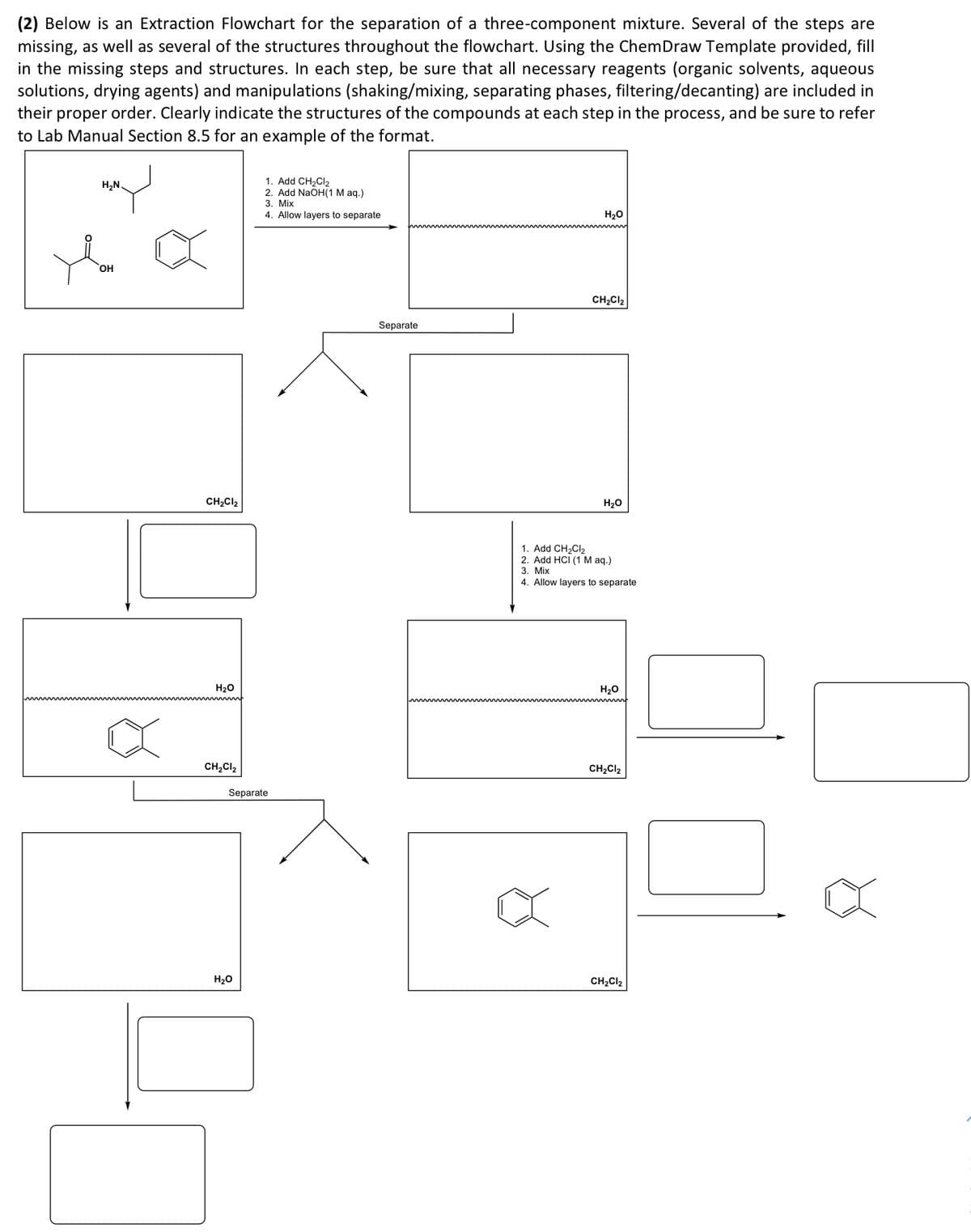(2) Below is an Extraction Flowchart for the separation of a three-component mixture. Several of the steps are missing, as well as several of the structures throughout the flowchart. Using the ChemDraw Template provided, fill in the missing steps and structures. In each step, be sure that all necessary reagents (organic solvents, aqueous solutions, drying agents) and manipulations (shaking/mixing, separating phases, filtering/decanting) are included in their proper order. Clearly indicate the structures of the compounds at each step in the process, and be sure to refer to Lab Manual Section 8.5 for an example of the format. 1. Add CH2CI2 2. Add NaOH(1 M aq.) 3. Mix 4. Allow layers to separate H,N. H20 HO, CH2CI2 Separate CH2CI2 H20 1. Add CH2CI2 2. Add HCI (1 M aq.) 3. Mix 4. Allow layers to separate H20 H20 CH,Cl2 CH2CI2 Separate H20 CH2CI2
(2) Below is an Extraction Flowchart for the separation of a three-component mixture. Several of the steps are missing, as well as several of the structures throughout the flowchart. Using the ChemDraw Template provided, fill in the missing steps and structures. In each step, be sure that all necessary reagents (organic solvents, aqueous solutions, drying agents) and manipulations (shaking/mixing, separating phases, filtering/decanting) are included in their proper order. Clearly indicate the structures of the compounds at each step in the process, and be sure to refer to Lab Manual Section 8.5 for an example of the format. 1. Add CH2CI2 2. Add NaOH(1 M aq.) 3. Mix 4. Allow layers to separate H,N. H20 HO, CH2CI2 Separate CH2CI2 H20 1. Add CH2CI2 2. Add HCI (1 M aq.) 3. Mix 4. Allow layers to separate H20 H20 CH,Cl2 CH2CI2 Separate H20 CH2CI2
Macroscale and Microscale Organic Experiments
7th Edition
ISBN:9781305577190
Author:Kenneth L. Williamson, Katherine M. Masters
Publisher:Kenneth L. Williamson, Katherine M. Masters
Chapter7: Extraction
Section: Chapter Questions
Problem 1Q
Related questions
Question
100%
need help with this ASAP pls & thank you! (it's asking for you to fill in the blank boxes)

Transcribed Image Text:(2) Below is an Extraction Flowchart for the separation of a three-component mixture. Several of the steps are
missing, as well as several of the structures throughout the flowchart. Using the ChemDraw Template provided, fill
in the missing steps and structures. In each step, be sure that all necessary reagents (organic solvents, aqueous
solutions, drying agents) and manipulations (shaking/mixing, separating phases, filtering/decanting) are included in
their proper order. Clearly indicate the structures of the compounds at each step in the process, and be sure to refer
to Lab Manual Section 8.5 for an example of the format.
1. Add CH2CI2
2. Add NaOH(1 M aq.)
3. Mix
4. Allow layers to separate
H,N.
H20
HO,
CH2CI2
Separate
CH2CI2
H20
1. Add CH2CI2
2. Add HCI (1 M aq.)
3. Mix
4. Allow layers to separate
H20
H20
CH,Cl2
CH2CI2
Separate
H20
CH2CI2
Expert Solution
Step 1
We are given 3 molecules to separate, out of which, one molecule is an acid with acidic -COOH group, one molecule is basic with basic -NH2 group, and the third molecule is a non-polar molecule with a benzene ring.
Trending now
This is a popular solution!
Step by step
Solved in 3 steps with 1 images

Knowledge Booster
Learn more about
Need a deep-dive on the concept behind this application? Look no further. Learn more about this topic, chemistry and related others by exploring similar questions and additional content below.Recommended textbooks for you

Macroscale and Microscale Organic Experiments
Chemistry
ISBN:
9781305577190
Author:
Kenneth L. Williamson, Katherine M. Masters
Publisher:
Brooks Cole

Macroscale and Microscale Organic Experiments
Chemistry
ISBN:
9781305577190
Author:
Kenneth L. Williamson, Katherine M. Masters
Publisher:
Brooks Cole